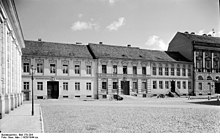New Market (Potsdam)
The Neuer Markt is a square in downtown Potsdam , it is one of the best preserved baroque squares in Europe. It has a rectangular shape of around 50 by 40 meters. In the middle of the square is the small building of the former municipal council scales. In contrast to the Old Market , the buildings have the character of representative town houses. The place is quiet and shielded behind rows of houses.
history
Horses were originally harnessed and unhitched at the Neuer Markt until the 18th century. From 1725 the old stable area shrank to its present size due to the construction of several houses. New town houses were built under Frederick the Great . In the later cabinet house at the Neuen Markt 1, the King Friedrich Wilhelm III. and Wilhelm von Humboldt born. The bombing and fighting in World War II damaged two buildings on the north corner and later demolished them. The council scales were used for the VEB fruit and juice trucks until the end of the 1970s. The Neuer Markt was extensively renovated at the end of the 1990s and closed again with a new building at Am Neuen Markt 5. Every year the Rose Festival takes place on the Neuer Markt.
Buildings and institutions
With the scientific institutions located here, the Neuer Markt is now a humanities center of Potsdam. Scientific institutions include the Center for Contemporary Historical Research , the Moses Mendelssohn Center for European-Jewish Studies and the Einstein Forum .
In the middle of the square is the former royal malt and grain scale . The scales were set up in a half-timbered house in 1735, and the proceeds went to the Royal Great Military Orphanage . The current building was erected in 1836, and the municipal council scales were moved here in 1875. The newer building was probably designed by Christian Heinrich Ziller , a student of Karl Friedrich Schinkel .
On the west side of the Neuer Markt is the old horse-drawn carriage stable with its early classical facade. Today the House of Brandenburg-Prussian History is located there .
The north side is characterized by the architecture of the time of Frederick the Great. As early as 1755, according to plans by Johann Gottfried Büring , the Bürgerhaus (Neumarkt 5) was built as a representative focal point from Schlossstrasse, the facade of which was modeled on the Palazzo Thiene of the Italian master builder Palladio . The building was destroyed in 1945 and rebuilt around 2000 by the architect Fortman-Drühe in a modified form that cites the original building. The adjacent two-story houses 6, 7 and 8 were built in 1773 by Georg Christian Unger . Today they house the Einstein Forum , the Moses Mendelssohn Center for European-Jewish Studies and the Berlin-Brandenburg Academy of Sciences .
On the east side is the cabinet house , which was built in 1753 on the instructions of Frederick the Great as a bourgeois residential building. From 1765 the building connected to the neighboring house at Schwertfegerstraße 8 served as the residence of Crown Prince Friedrich Wilhelm . Here the later King Friedrich Wilhelm III. (1770) and also Wilhelm von Humboldt (1767) born. From 1788 to 1806 the house was the seat of the Royal Engineering Academy of the Prussian Army under Major General Heinrich Otto von Scheel and Bonaventura von Rauch as directors. In 1833 the king bought the house for the royal Prussian cabinet; The current name Kabinetthaus was retained from this time.
To the south, the Potsdam Film Museum borders the Neuer Markt, which is housed in the former stables of the city palace .
See also
Web links
- Side of the city of Potsdam: From the Neuer Markt to the city canal
- Side of the city of Potsdam: Friedrich Wilhelm I. - The "Soldier King" and his Potsdam
Coordinates: 52 ° 23 '47 " N , 13 ° 3' 27" E





